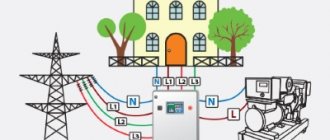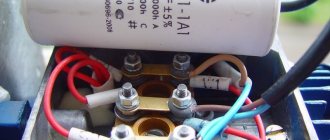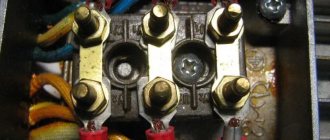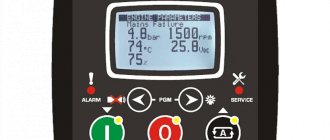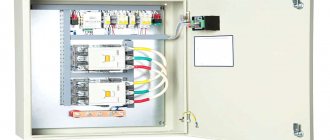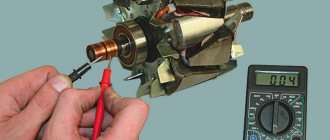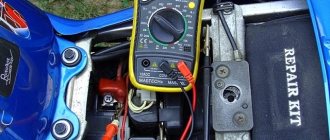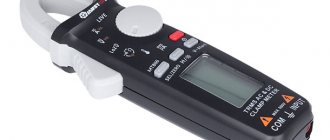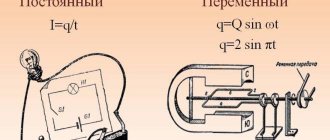What is AVR
This is a block consisting of several nodes, which automatically switches the load between the main and backup current sources. Some single-phase and three-phase models of gasoline and diesel generators are equipped initially. To switch the load, you only need to install a special switch after the electric meter. The position of the power contacts is controlled by the main power source.
Read also: Voice Changer & Modulator
Almost all models with a battery-powered power plant can be equipped with autonomous ATS systems. In this case, ATS cabinets are used to install backup input units. In this case, ATS panels (Figure 1) can be placed directly next to gas generators or the units can be installed in a common electrical panel.
Figure 1. Example of an ATS electrical panel
Is it possible to connect welding when ABP is running?
You probably understand that autostarting a gas generator is good, but the carburetor unit cannot handle all the powerful equipment. As an example, we will consider the choice of a device that will be sufficient for electric welding, as one of the most powerful energy consumers possible in domestic conditions. At the same time, we will consider compromise solutions when the main device is not only a welding machine, but also a generator with a diesel, gas or carburetor. By the way, no less power will be required for a carpentry workshop if it is equipped with professional equipment.
So, if your autostart system for a gasoline generator is equipped with an inverter and the output power of the unit indicated in the documents or on the case coincides with the welding power consumption, that’s not all. There are not only basic, but also additional quantities that affect voltage:
Note: it is also important to consider the condition of the electrical wiring in the building and the welding modes provided for the time when the generator will automatically start in the event of a power outage.
It is very important to take into account the factor of false information, that is, not very powerful inverters connected to the ABP circuit are not always capable of delivering 220 V. But in such cases, we turn to the technical parameters of the welding machine and, if the unit is capable of operating at a voltage of 150-200 V, it means everything is fine and you won't have any problems.
When it is known in advance that when the main power source is turned off, a reserve will be automatically introduced, and welding work will be carried out, it will not be amiss to study the table given above. This way you can choose the optimal ratio for a generator with ABP and an electric welding machine.
Advice: when choosing the ratio of the power of the generator and the welding machine, it is best if there is a reserve at the output, that is, when you enter a reserve, you will get more than what is needed for the operation of the equipment.
ATS connection diagrams and their descriptions
The main function of the ATS is to automatically switch inputs, and in such a way as to eliminate counter currents.
A simple diagram in Fig. 4 explains the switching principle.
Read also: How to make Ghee
Figure 4. ATS diagram
Contacts KM1 and KM2 are interconnected. After one contact opens, the other closes. They cannot be turned on at the same time.
There are many different schemes for connecting automatic transfer input, but the principle of their construction is always the following: ATS is installed between the input and consumers. Usually after the electric meter. The automatic switchboard itself can be located anywhere, but the principle of its connection is exactly the same. This principle is clearly illustrated by the diagram in Fig. 5.
How to ensure that the generator starts automatically during a power outage
We will send the material by email
When the light goes out in the house, people behave differently, since for some it is simply the inability to watch TV, but for others it is a blocking of activities, especially if a person has some kind of workshop equipped with electrical appliances. It is clear that in the second case, automatic switching on of the generator during a power outage will be an urgent need. And in this article we will talk specifically about automatic, rather than manual, starting of the reserve.
About contactors
Thus, the use of conventional relays is out of the question for us; only specialized contactors are suitable. For higher powers there is also an option with motorized drives, but this is expensive and redundant for typical home use.
To make a mechanical interlock, you need to select contactors that can work in pairs. Typically, mutual interlocking is achieved by installing identical contactors next to each other and installing an additional option - a mechanical interlock. It is sold separately from contactors and costs pennies.
How to assemble an AVR with your own hands
If you are familiar with the basics of electrical engineering, you can try to make an ATS yourself, based on the diagram. But it is better, of course, to entrust this to a specialist with experience in assembling electrical panels.
To assemble the AVR unit with our own hands, we will need:
- Three-pole starters with blocks of additional contacts (1NO and 1NC) – 2 pcs. The power is selected based on the input circuit breaker installed in your panel.
- Automatic switches: Three-pole, current corresponding to contactors - 2 pcs (QF1, QF2) and 1 pc. to protect the voltage control relay - 3p S6A (QF3). Single-pole – B6A – 1 piece (QF4).
- Voltage monitoring relay CM-PVE or equivalent (KV).
- Modular contactor with 220V coil and three contacts (2NO and 1NC) (KL1). How to assemble an AVR with your own hands.
- Signal lamps for 220V, one red and one green (HL1, HL2).
- A metal cabinet with a mounting plate and dimensions corresponding to the equipment being installed (everything should not be end-to-end, and there should not be too much free space).
- DIN rail – approximately 0.5 m.
- DIN rail terminals - if desired, you can do without them by connecting cables directly to breakers and contactors.
Below is an approximate location of the equipment in the shield. Then everything is simple, first we wire the power lines using the mounting wire PV3 or PuGV (the cross-section is not lower than the cable coming from the network), and then the control circuits with the same wire are only 1mm2. PuGV and PV3 are necessarily pressed into NShVI tips.
Approximate location of the equipment in the panel.
Reserve input circuit with zero break
Without a break, it can be used if you have two independent power lines or cable inputs, from which you actually connect the entire house. But when the backup line is some kind of autonomous energy source - a UPS or a generator, then you will have to break both the phase and the neutral.
Since the main network in 90% of cases is made with a solidly grounded neutral, and from a generator or UPS it comes with an isolated one. Here it is impossible to combine the zero working conductor from the network with the zero from the generator.
Naturally, all contactors are connected after the kWh meter. QF are modular circuit breakers in a home panel.
If you have a second power source that does not supply voltage automatically, for example, a gasoline generator without starting equipment. Which must first be manually started, warmed up and only then switched, then the circuit can be slightly changed by adding one single button.
Due to this, automatic switching will not occur. You choose the right moment for this by pressing it when needed. This button SB1 is mounted parallel to the contactor coil.
When the voltage at the main input does not disappear for a long time, but periodically disappears and appears (the reasons may be different), in this case it is not advisable to constantly switch the contactors back and forth. Here it is advisable to use a special attachment to a PVI-12 type contactor with a time delay.
Connecting the generator to the home network
Power outages are quite common in the private sector, so a backup source of energy never hurts. In this article we will talk about how to properly connect a generator (examples of models FUBAG TI 2600, Hyundai HHY3000FE, Champion GG951DC) to the home network.
Calculation of permissible load
When choosing a generator, you should calculate the load to which it will be subjected. Not only the rated power of all connected electrical appliances must be taken into account, but also inrush currents with a possible increase in consumption.
Each group has its own coefficient by which you need to multiply the rated power of the device.
- Household appliances (refrigerator, TV, etc.) – from 1.2 to 1.5.
- Heaters and incandescent lamps – 1.
- Powerful equipment (machine, transformer, pump, etc.) – 3.
- Hand tools (electric drill, jigsaw, angle grinder, etc.) – from 1.5 to 2.
If the sum of the values exceeds the permissible power of the generator, the use of some device will have to be abandoned. Even short overloads are very harmful. At the same time, constant low loads (less than 30% of the nominal value) are also contraindicated for the generator. Operating at half strength negatively affects its performance.
Connection methods
Some fans of simple solutions connect to the mains using a plug-to-plug adapter. One end is inserted into the socket, the other into the generator.
The problem is that when electricity returns, the energy source or the devices connected to it may simply fail. If you do not want to take such risks, it is better to refrain from such an “easy” decision.
There are two main ways to connect a generator to a home network:
- through a changeover switch;
- using an automatic control unit.
Application of AVR
Those who want not to bother with connecting a generator every time can install an automatic control unit. As soon as the electricity goes out, the AVR system independently activates the energy source. The unit is connected to the electrical panel. It is connected to the generator by a cable.
ATS on two contactors or magnetic starters
Using two contactors, you can implement a very simple and understandable scheme for automatic power backup:
The circuit is very simple, designed for single-phase circuits. There are a minimum of details, but the circuit is nevertheless ready for practical use. Operating procedure: turn on SA1 and SA2 alternately. If the voltage was at input 1, then it will power the load, input 2 will be backup. In this scheme there are no explicit main and backup inputs. If the voltage disappears at one of the inputs, the power will switch to the other. If voltage reappears at the disconnected input, nothing will happen until the voltage at the switched-on input disappears.
The circuit is quite reliable even without mechanical interlocking of the starters, which, however, will also not be superfluous. To switch the power to another input, it is enough to briefly turn off the power to the input using the SA1 or SA2 circuit breaker. The logic of the circuit is simple, so there is nothing special to describe. The closing contacts of the contactors must be designed for the full load current; for the breaking contacts this does not matter (block contacts can be used).
Currently, the industry produces a wide range of ready-made AVR units. Basically, this is a programmable controller in a block with output relays. The most popular and cheap devices are usually made for mounting on a DIN rail, approximately 15 wide standard single-pole circuit breakers. Let's consider one of them, relatively simple.
Additional automation
Electricity does not always go out for a long time; there are breaks of one or two minutes. In this case, starting a backup generator is impractical and even harmful for it. In addition, the engine may not start the first time. The problem is solved by installing after the NC 1 multifunctional programmable time relay, powered by +12 volts.
For example, the Songle SRD-12VDC-SL-C model, designed for an operating current of 10 amperes. It can delay the supply of voltage for up to a week. And also perform a cycle of on-off switches, the duration of which and the intervals between them are programmed by simply pressing the buttons on the board. For ease of use, the model is equipped with a four-digit liquid crystal display.
As you can see, creating a generator autostart circuit with your own hands is not so difficult. It works no less reliably than ATS on DATACOM brand controllers, the cost of which reaches 15 thousand rubles.
Self-production of AVR
If you purchased a generator with an electric starter, you can automate the process of introducing the reserve yourself. To do this, you need to choose a scheme that meets the characteristics of your home network. After that, buy all the necessary parts, taking into account the power of consumers.
You will need:
- Universal controller.
- Contactors (for the simplest circuit - at least 2).
- Electrical cabinet.
- Three-level operating mode switch.
- Power supply for 1 - 3 Amps.
- Automation for starting/stopping the generator engine (if it is not equipped with one).
- Connecting cables, working tools.
Stages of work:
- Cabinet installation. Select a suitable location for the electrical panel (preferably closer to the main input).
- Installation of parts. Place all components so that all contactors and terminals are accessible.
- Connecting lines. Strictly follow the diagrams and observe the terminal assignments. Use the markings on the covers and housings of the devices. Make sure that the wires do not cross. Lastly, connect the input wires, of course, with the input circuit breaker turned off.
- After installation, be sure to test the operation of the ATS unit.
Through an automatic (distribution) switch
The ideal option is if the panel has an outlet. This method should not be confused with the one described above. On the electrical goods market, some ready-made panels are initially equipped with such outputs (it is recommended to choose them for private households). Sometimes, when assembling the panel yourself, they install an incoming AV, a meter, an RCD and one or two sockets for insurance, so it is convenient to carry out repairs. Then the generator can be connected there without any problems.
You need to be reliably aware that this is not an ordinary power outlet.
The rules must be followed:
- the socket must pass at least 16 A or more under the power of the backup device;
- AV at the input must be disabled.
If the described elements are not in the shield, then remove the input wires from the switchboard and connect the device directly to it. If RCDs and RCBOs are further installed, the polarity must be observed. Let us remind you: if you connect to the “firefighter” AB in front of the metering device, the circuit will work, but the meter will count its own electricity already produced. The introductory AB is sealed by energy sales, so more often than not the possibility of this option is completely absent. It is necessary to choose exactly the distribution (group, common) AB or RCBO after the metering device.
Algorithm of actions:
- Turn off the input machine. After connecting the backup source, it can be activated again, and this will be necessary before installing the control lamp.
- Unscrew the clamps on the switchgear terminals and remove the wiring.
- In place of the indicated cores, observing the polarity, especially if further than the RCD, RCBO, connect the cores from the generator cable.
- You can mount a light bulb on the folded wires, which will indicate the resumption of the main power supply; after installing it, the introductory circuit breaker is turned on.
Selecting ATS
The table below will help you decide on the type of ATS.
| ATS type | Device Features | Action |
| Single acting | Two sections. One working and one backup | Connects a backup line in case of power failure on the main one |
| Double acting | Sections are equivalent | You can connect any line, regardless of voltage availability |
| With restoration | Monitors the presence of voltage at the main input after switching to backup power | When voltage appears on the main line, it transfers the circuit (with a slight delay) to its original state |
| No recovery | Switches sections after voltage loss at the main input | Operator intervention is required to switch to main mode |
Classification by type
First of all, you need to know which object will be powered from an alternative source; in this case, there are two types of devices:
This device can also be divided into types of fuel consumed for operation:
There are also solid fuel types of devices, but they are less common. If we consider the above, each has its own advantages and disadvantages.
A diesel backup power source , as a rule, is more expensive than its counterparts operating on other types of fuel; it does not perform very well in frosty weather, which forces it to be installed in separate enclosed spaces, and its engine is noisier. The advantage of this device is its longer service life, the engine is less subject to wear, and devices of this type have quite economical fuel consumption.
A gas electric generator is the most economical if you look at the level of fuel consumption in comparison with its competitors, it is less noisy and has a long service life with proper operation. The main disadvantage is the danger of working with gas and more difficult refueling.
The gas generator, the most common and easy to operate, is represented by the largest number of models on the market, in a wide variety of price categories, which is its main advantage. Disadvantages of such a device: high fuel consumption, short service life, but at the same time it is most often purchased for domestic purposes and is prepared for automatic switching on of the generator when the power goes out.
